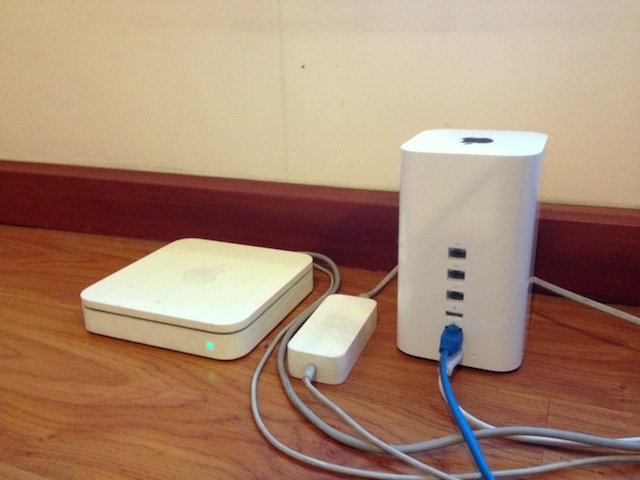Apple AirPort Extreme Router in Thailand (1): New Design and Faster Wi-Fi with 802.11ac (Amended)

AMITIAE - Wednesday 26 June 2013
|
Apple AirPort Extreme Router in Thailand (1): New Design and Faster Wi-Fi with 802.11ac (Amended) |
 |
|
|
By Graham K. Rogers
The most obvious difference out of the box is the shape. Previous generations of the AirPort router have been flat, square boxes with rounded corners (something like a Mac mini). The latest version is now taller: to accommodate the changed antenna setup and (finally) to include a power supply within the enclosure.
The power brick for the older router was made by Fugang Electronic (Dongguan) Cd., Ltd., while I am unable to identify where the router itself was made. When first installed, it only recognised Taiwan as a country option. In January 2007 it was priced at $179 (8,000 baht) here. It arrived in Thailand several months later and I bought mine in early December that year: 6 years of almost daily use and it runs faultlessly. The latest version (A1521) was announced in early June at WWDC and began shipping to Thai customers from the Online Apple Store on 27 June. The device was assembled in China but neither the box nor the device itself have information about where it was made. The iFixit teardown indicated Delta Electronics which does have factories in Thailand (Chachoengsao, Samut Prakan) as well as other locations. It was priced at $199 (6,200 baht here with taxes): enhanced features, lower price. For those who qualify for an education discount, it is a few hundred baht less. There are also Time Capsule versions with 2TB or 3 TB disks for $199 and $399 (9,500 baht and 12,500 baht) respectively. The differences in pricing between the current and earlier versions may in part be due to exchange rate fluctuations. There was no Online Store for Thailand when I bought the earlier device.
The pre-announcement of the Mac Pro also included this new standard, so it is no stretch of the imagination to speculate that the next MacBook Pro computers will also have 802.11ac installed. Just as important to networked data sharing in the home and office are the iOS devices, so it is almost a given that the next version of the iPhone (and the iPad) will also be 802.11ac capable. The strategy concerns integration now and has done for a couple of years - which do many other would-be market leaders miss. With faster networking that is able to carry far larger files (the "fat pipe") data transfers within the home or office environment become far more effective. Apple puts the foundation down and then provides the bricks.
While looking through the web for information about the 802.11 ac standard (ac because IEEE ran out of letters: after 802.11z, they start again with 802.11aa, 802.11 ab, 802.11 ac and so on). As well as some solid factual information, there is also some useful speculation:
As this was a device specifically for the Thai market, the entire manual was in Thai. At least one other person on the UPS man's delivery list was not Thai (and there will be others), so a dual-language version might have been more helpful. It was easy enough to link to the relevant Apple Support page and open the PDF of the Airport Setup Guide (US version) in a browser. The pages and the information in the Thai version of the guide follow the US guide closely. There is also a manual for the Airport Time Capsule. While the device can be set up using a Mac, an iPhone, iPad or iPod touch, I stuck to the Mac as I was already familiar with the Airport Utility (v 6.3). However, as I am more wary of Wi-Fi routers than other hardware, I read the manual carefully and made some tea before setting up the device.

See AlsoApple AirPort Extreme Router in Thailand (2): Installation and Setup with Comments on Limitations
Graham K. Rogers teaches at the Faculty of Engineering, Mahidol University in Thailand where he is also Assistant Dean. He wrote in the Bangkok Post, Database supplement on IT subjects. For the last seven years of Database he wrote a column on Apple and Macs. |
|

For further information, e-mail to

|

|